Cathy Burnham Martin's Blog, page 81
April 23, 2023
National Picnic Day

Each year on April 23, we celebrate National Picnic Day. Take some time to spread out a blanket anywhere and enjoy peace and tranquility or perhaps just listen to Nature or watch waves lapping a shore or catch an outdoor concert. Share the time with special people or a special person or a pet or simply by yourself.
Take some favorite foods to nibble, of course. Because food is central to the picnic experience, here are 3 Super Simple considerations for you.
 Super Simple Caprese Sandwiches or Kebabs
Super Simple Caprese Sandwiches or Kebabs
Slices of fresh, ripe tomatoes (or cherry tomatoes for kebabs)
Slices of mozzarella cheese (or mini balls for kebabs)
Fresh basil leaves
Balsamic glaze or a favorite pesto
Bread or rolls (or mini bamboo or wooden skewers for kebabs)
Layer the goodies on your bread (closed or open-faced) or thread on your skewers and drizzle.
 Super Simple Peach Salsa
Super Simple Peach Salsa
¼ c chopped red or sweet onion, microwaved & chilled
2 c diced peaches or nectarines
2 diced Roma tomatoes
½ c diced, seeded cucumber
½ jalapeño, seeded & finely diced
2 T chopped fresh cilantro
Juice of 1 large or 2 small limes
½ tsp salt & ¼ tsp pepper
Combine and chill for 2-24 hours. Serve with favorite tortilla chips.
KISS Tip: You can make this extra Super Simple by simply stirring peaches into a favorite bottled salsa!
 Super Simple Sparkling Lemonade
Super Simple Sparkling Lemonade
1 lb hulled & sliced fresh, ripe strawberries
¼ – 1/3 c granulated monkfruit or sugar
½ c water
¾ c freshly squeezed lemon juice (or lime, if preferred)
4 c Prosecco or sparkling water (for a family-friendly version)
Sprinkle berries with sweetener in a bowl; stir twice as it rests for 1 hour. Add the half cup water & process till smooth with an immersion blender (or mash thoroughly). Strain through a fine sieve or cheesecloth to remove seeds. Stir in lemon juice and refrigerate. To serve, divide mixture among 4 glasses atop ice cubes; then pour the bubbly over the top. If desired, you can garnish with a lemon wedge, fresh berry, or mint sprig.
April 22, 2023
Judgment

“We judge ourselves by what we feel capable of doing, while others judge us by what we have already done.”
— Henry Wadsworth Longfellow
(1807 – 1882)
American poet
April 21, 2023
High Five!
 We’re taking a look back today at National High Five Day, which is always the third Thursday of April. Officially, that was yesterday.
We’re taking a look back today at National High Five Day, which is always the third Thursday of April. Officially, that was yesterday.
We recognize the gesture of greeting, happiness, celebration, or congratulations. It’s easy to cheer someone else on, but we often struggle to support ourselves with the same confidence. So, why not start today and each day celebrating yourself with a high five!?!
 According to the Oxford Dictionary, the “high five” has been around since the early 1980s and is related to the slang expressions “give me five”, “slap me five”, “slip me five”, and “give me some skin”. It is the recognizable request for some form of handshake with the “five” referring to the digits of the hand.
According to the Oxford Dictionary, the “high five” has been around since the early 1980s and is related to the slang expressions “give me five”, “slap me five”, “slip me five”, and “give me some skin”. It is the recognizable request for some form of handshake with the “five” referring to the digits of the hand.
Like the “fist bump,” such gestures convey respect, approval, and companionship. And, yes, such a fun “trick” to teach to our favorite furry friends!

Origins are up for debate. Most people think it likely started in baseball or basketball. Some specifically recall Glenn Burk and Dusty Baker of the Los Angeles Dodgers sharing a high five on October 2, 1977, following an important home run. Others credit the Louisville Cardinals basketball players Wiley Brown and Derek Smith during the 1978-89 season. The usual “low five”, a popular symbol of support since around 1920 in the Black community, was enthusiastically delivered up high for emphasis.
 In truth, there are possibilities that go back much further. A high five-style raised hand slap is depicted as far back as 3200 BC in ancient Egyptian hieroglyphics.
In truth, there are possibilities that go back much further. A high five-style raised hand slap is depicted as far back as 3200 BC in ancient Egyptian hieroglyphics.
So, be it yesterday, today, or tomorrow, this is a good day for a high five. The power of support and solidarity is always welcome. So, here’s a high five to y’all!
April 20, 2023
Trust

“Love all, trust a few, do wrong to none.”
— William Shakespeare 1564 – 1616)
English playwright
April 19, 2023
Happiness

“There is no path to happiness; happiness is the path.”
— Siddhartha Gautama (the Buddha)
(Born 564 BC)
Founder of Buddhism
April 18, 2023
More on Ellis Island
 Yesterday I mentioned that Ellis Island had a dark past. Before becoming a major immigration center, it was used for hanging condemned prisoners, pirates, criminals, and mutinous sailors from the early 1800s through 1839. It then served as a Navy munitions depot before being repurposed as a federal immigration station.
Yesterday I mentioned that Ellis Island had a dark past. Before becoming a major immigration center, it was used for hanging condemned prisoners, pirates, criminals, and mutinous sailors from the early 1800s through 1839. It then served as a Navy munitions depot before being repurposed as a federal immigration station.

Photo courtesy of the New York Public Library
In truth, Ellis Island was not an immigrant’s first stop in America. Waters around the island are not deep enough for the steamships, so ships initially docked and unloaded all passengers in Manhattan. U.S. citizens and all other first- and second-class passengers entered the country there. However, all passengers in steerage were then herded onto ferries and shuttled to Ellis Island for processing.
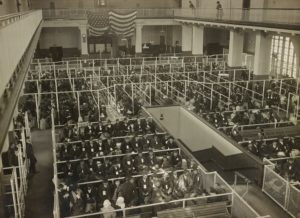
Photo courtesy of the New York Public Library
Upon arrival at Ellis Island, immigrants were ushered into the Great Hall to undergo a series of examinations for both physical and mental fitness. This is where some immigrants’ tags were marked with chalk and taken for additional screening, hospitalization, or deportation. Though America heralded its open immigration policy, anyone could be denied admittance if it seemed likely that person could become a financial burden for the government.
Despite folklore to the contrary, foreign-sounding names were not shortened nor “Americanized” at Ellis Island. Immigration officers merely checked names against each ship’s own passenger manifest. Name changes typically happened before or while boarding ships in foreign ports.
There are many more “little known facts” regarding immigration to America. For example, women could not leave Ellis Island with a man not related to them. Other automatic detainees included stowaways, alien seamen, anarchists, Bolsheviks, criminals, and anyone suspected of being “immoral.”
In 1790, US naturalization required 2 years of residency and “good moral character. Plus, the applicant had to be a “free white person.” In 1795 the residency period was extended to 5 years and then to 14 years in 1798, but back to 5 years in 1802. In 1870 the right of citizenship was extended to those of African origin.
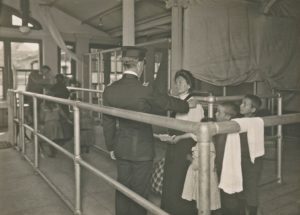
Photo courtesy of the New York Public Library
To be admitted during the nation’s open immigration years, arriving people had to be seen as healthy and able to enter the workforce. Any sign of declining physical or mental health could get someone deported. More than 60 diseases and disabilities could disqualify a person from entry. Sick children were separated from their parents. Wheezing, coughing, shuffling, or even limping could get a person hospitalized, rather than admitted to the U.S. In truth, tens of thousands of immigrants were hospitalized on the south side of the island, where they were held for treatment and possible deportation. More than 3,500 immigrants died in this hospital.
When the Civil War began in 1861, the demand for workers increased. Pro-immigration Republicans and President Abraham Lincoln advocated for better immigration policies. Progressives championed literacy tests and “various other eugenics-inspired racial and ethnic exclusions of Jews, Asians, and Africans.” By 1875 immigration restrictions included bans on criminals, people with contagious diseases, polygamists, anarchists, beggars, and importers of prostitutes. Ellis Island became more famous for deportations than immigration. In the early 1900s, many Progressives argued that immigrants “impeded the achievement of an ideal society, committed crimes, and abused welfare.”
U.S. immigration sentiment had grown quite negative by April 1917. People sought restrictions, fearing that many of the newcomers were racially inferior. Warnings included the danger of our “melting pot” philosophy bringing an impoverished, criminal, radical, and diseased horde.
 In 1921, President Warren G. Harding signed into law the first Quota Act, ending America’s open-door policy. The new law set monthly quotas and limited admission of each nationality to 3% of its representation in the 1910 U.S. Census. By 1925, the government shifted the inspection process from American ports to U.S. Consulates abroad. Ellis Island then operated primarily as a detention and “deportation point for undesirable immigrants.”
In 1921, President Warren G. Harding signed into law the first Quota Act, ending America’s open-door policy. The new law set monthly quotas and limited admission of each nationality to 3% of its representation in the 1910 U.S. Census. By 1925, the government shifted the inspection process from American ports to U.S. Consulates abroad. Ellis Island then operated primarily as a detention and “deportation point for undesirable immigrants.”
 Wear and tear took its toll on the buildings at Ellis Island. Eventually, restorations were ordered, and the facilities opened for tourist visitors during our nation’s Bicentennial in 1976. Some 3 million visitors tour Ellis Island annually. People can access Ellis on the same ferry as the one to the Statue of Liberty. While on the island, many look up ancestors who first arrived there.
Wear and tear took its toll on the buildings at Ellis Island. Eventually, restorations were ordered, and the facilities opened for tourist visitors during our nation’s Bicentennial in 1976. Some 3 million visitors tour Ellis Island annually. People can access Ellis on the same ferry as the one to the Statue of Liberty. While on the island, many look up ancestors who first arrived there.
April 17, 2023
National Ellis Island Family History Day
 If you love ancestry, checking out Ellis Island is a riotous “rabbit hole” to investigate. I had family enter the U.S. there, as did the nearly 40% of American citizens who can trace at least 1 ancestor to Ellis Island. 40%! That’s HUGE! It all started in 1892.
If you love ancestry, checking out Ellis Island is a riotous “rabbit hole” to investigate. I had family enter the U.S. there, as did the nearly 40% of American citizens who can trace at least 1 ancestor to Ellis Island. 40%! That’s HUGE! It all started in 1892.
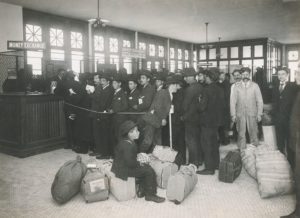
Photo courtesy of the New York Public Library
Three unaccompanied minors, 17-year-old Annie Moore, a teenager from County Cork in Ireland, and her 11 and 7-year-old brothers, were the first immigrants to come through Ellis Island on January 1, 1892. They were among the 124 passengers aboard the steamship Nevada. On one single day in 1907, more than 11,000 immigrants arrived. Ellis Island, named for Samuel Ellis, its last private owner, served as the port of entry for more than 12 million immigrants, until the site was permanently closed in November 1954.
 Ellis Island lies between NY and NJ… not far from the Statue of Liberty. Originally 3.3 acres in size, it was intentionally expanded to 27.5 acres to accommodate more people and buildings. Ellis Island sits in the waters of New Jersey, but an 1834 agreement stated the island belonged to New York. A 1998 agreement stated that the original 3.3 acres of land belonged to NY, but the additional 24.2 acres belonged to NJ.
Ellis Island lies between NY and NJ… not far from the Statue of Liberty. Originally 3.3 acres in size, it was intentionally expanded to 27.5 acres to accommodate more people and buildings. Ellis Island sits in the waters of New Jersey, but an 1834 agreement stated the island belonged to New York. A 1998 agreement stated that the original 3.3 acres of land belonged to NY, but the additional 24.2 acres belonged to NJ.
 Regardless of which state owned the island, all entrants approaching the United States were stopped for a quarantine checkpoint off Staten Island before their ships were even permitted to enter New York Harbor. Doctors check for dangerous contagious diseases, such as smallpox, yellow fever, plague, cholera, and leprosy. Plus, travelers in steerage and their belongings were sprayed down with disinfectant. After inspection, immigration officers then boarded the ship and began clearing U.S. citizens and all other 1st and 2nd class passengers. Most travelers, those in steerage, were given manifest tags to present to U.S. Customs officers to identify passengers. No passports or visas were required, nor were any papers needed.
Regardless of which state owned the island, all entrants approaching the United States were stopped for a quarantine checkpoint off Staten Island before their ships were even permitted to enter New York Harbor. Doctors check for dangerous contagious diseases, such as smallpox, yellow fever, plague, cholera, and leprosy. Plus, travelers in steerage and their belongings were sprayed down with disinfectant. After inspection, immigration officers then boarded the ship and began clearing U.S. citizens and all other 1st and 2nd class passengers. Most travelers, those in steerage, were given manifest tags to present to U.S. Customs officers to identify passengers. No passports or visas were required, nor were any papers needed.
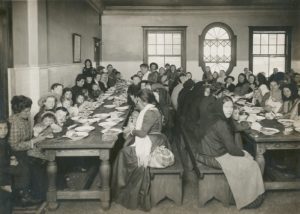
Photo courtesy of the New York Public Library
80% of those arriving spent 3-5 hours getting through the Ellis Island process and were then admitted. However, the process for the other 20% could take a couple of days, weeks, months, or in rare cases, a couple of years. While waiting, free meals were served. This usually included beef stew, potatoes, bread, bananas, and ice cream. Dormitories were provided for longer waiting periods. About 2% or less than half a million people were denied entry and sent back to their ports of origin.
 Arriving in 1916 as a small child, along with an older brother and his mother, my Armenian grandfather and his family were nearly among those deported. That fact is visible today upon examining the records at Ellis Island. Language challenges had made it difficult to help officials understand that his mother had been badly injured by Ottoman Turk soldiers, rather than being ill with some dreaded disease. Though it took a lot of time and tears, they finally were able to find someone who could help communicate, and they were able to join relatives waiting on the shore, rather than being sent back to Europe.
Arriving in 1916 as a small child, along with an older brother and his mother, my Armenian grandfather and his family were nearly among those deported. That fact is visible today upon examining the records at Ellis Island. Language challenges had made it difficult to help officials understand that his mother had been badly injured by Ottoman Turk soldiers, rather than being ill with some dreaded disease. Though it took a lot of time and tears, they finally were able to find someone who could help communicate, and they were able to join relatives waiting on the shore, rather than being sent back to Europe.
I was most pleased to share their store in the first two books of my Destiny historical fiction trilogy. “Destiny of Dreams” tells a blunt and difficult account of my ancestors’ struggles in Armenia, and “Destiny of Determination” follows the survivors arriving at Ellis Island and building a new life in America. (The concluding book in the trilogy is due for release this Fall.)

Tomorrow, I will continue sharing about Ellis Island. We’ll look at why it earned the “Island of Tears” nickname and how it grew out of its dark past into a popular tourist destination.
April 16, 2023
National Eggs Benedict Day
 Chef Charles Ranhofer is credited with creating Eggs a la Benedict at Delmonico’s Restaurant in Lower Manhattan. He came up with the combination in the 1860s when a regular diner, Mrs. LeGrand Benedict, sought something new on the menu. The dish began being served regularly at Delmonico’s, and Chef Ranhofer finally published the recipe in his 1894 cookbook.
Chef Charles Ranhofer is credited with creating Eggs a la Benedict at Delmonico’s Restaurant in Lower Manhattan. He came up with the combination in the 1860s when a regular diner, Mrs. LeGrand Benedict, sought something new on the menu. The dish began being served regularly at Delmonico’s, and Chef Ranhofer finally published the recipe in his 1894 cookbook.
Some attribute the recipe to a Lemuel Benedict. Legend says that in 1894, in a somewhat drunken state, he meandered into New York’s Waldorf Hotel and ordered bacon and a poached egg on toast. The maître d’, one Oscar Tschirsky thought the combination would make a tasty addition to the menu, but he switched the bacon to Canadian bacon and the toast to an English muffin.
Hmmmm… then again, it should be noted that Tschirsky had previously worked at Delmonico’s Restaurant, right around the same time that Eggs a la Benedict started becoming popular. Okay, so he perhaps “pinched” it.
Regardless, Eggs Benedict is easy to make at home. Jazz it up or keep it Super Simple. You choose.
 First, use a packet mix or make your own Hollandaise sauce. An immersion blender makes it in a snap!
First, use a packet mix or make your own Hollandaise sauce. An immersion blender makes it in a snap!
Hollandaise Sauce
¾ c butter
3 lg egg yolks
3 T water
2 T fresh lemon juice
Kosher salt & pepper
Melt the butter in a microwave or small pan till bubbly. Meanwhile, place eggs, water, & lemon juice in a bowl and start blending with the immersion blender. Then, very slowly drizzle the butter into the bowl, still constantly blending. Season with salt & pepper and cover with plastic wrap while preparing the other ingredients.
To poach your eggs, break each egg, one at a time, into a small bowl, such as a custard cup. If the yolk breaks, set it aside for some other use. Slide up to 4 eggs at a time into a pot of simmering hot water. Cook just 3-4 minutes so they will set but still have runny yolks. Gently remove them to a paper towel-lined plate to drain.
Assemble each serving of Eggs Benedict by placing both halves of a toasted English muffin, cut sides up, on a plate. Top each with a slice or two of seared Canadian bacon, followed by a poached egg and a large spoonful of Hollandaise sauce. Garnish each with a sprinkle of finely sliced chives or other chopped fresh herbs and serve with some crispy home-fried potatoes and some fresh fruit.
 Then you can start to imagine the possibilities! You could kick this up to a lunch entrée by replacing the English muffins with a baked potato. (Remove the hot pulp, mash, add butter, salt & pepper; then return the seasoned pulp to the potato skin and top with the bacon, egg, and Hollandaise sauce.
Then you can start to imagine the possibilities! You could kick this up to a lunch entrée by replacing the English muffins with a baked potato. (Remove the hot pulp, mash, add butter, salt & pepper; then return the seasoned pulp to the potato skin and top with the bacon, egg, and Hollandaise sauce.
Consider supplementing or varying the protein. Try Florentine Eggs Benedict by adding sauteed spinach and sliced mushrooms. Go for Eggs Benedict Royale by replacing the Canadian bacon with smoked salmon. Replace the Canadian bacon with crispy strips of traditional bacon and/or sauteed, sliced sweet onions. Or replace the bacon with sliced turkey and serve over a pan-fried cake of leftover stuffing. Another fun twist is to use thinly sliced ham and sliced fresh avocado.
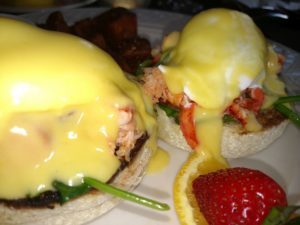
Of course, there’s my own personal favorite. Go for Super Simple Neptune Eggs Benedict by replacing the Canadian bacon with lobster or king crab legs, lightly sautéed in salty butter. This is perfect with thin asparagus spears or baby spinach leaves between the seafood and a toasted, buttered English muffin.
April 15, 2023
Take a Wild Guess Day
 Celebrate the silly, the scintillating, the serious thinker in all of us! We spend a great deal of time in our lives trying to seek exactly the correct answers. Whether we are guessing how many dandelions are budding in a meadow, attempting to count jellybeans in a huge jar, or estimating our taxes, we all have inklings and premonitions.
Celebrate the silly, the scintillating, the serious thinker in all of us! We spend a great deal of time in our lives trying to seek exactly the correct answers. Whether we are guessing how many dandelions are budding in a meadow, attempting to count jellybeans in a huge jar, or estimating our taxes, we all have inklings and premonitions.
(Okay, Uncle Sam expects far more than a good guess.)
But today is Take a Wild Guess Day, so follow your gut feel. Hail to the hunches. Glorify the guesses… even the wild ones! We may be way off base or hit the bull’s eye!
April 14, 2023
National Look Up to the Sky Day

If the weather cooperates, great! If not, great! On National Look Up to the Sky Day, let’s take a moment to look up and appreciate our world from a different perspective. Look outward… no selfies!
 Brilliant blue skies… stunning cloud formations… the gray of dense rain. Catch a blazing sunrise or sunset… or remember one that was particularly spectacular. Do some star gazing. Listen to a “sky”-themed song or two… “Lucy in the Sky with Diamonds,” “Spirit in the Sky,” or “Sky Pilot.”
Brilliant blue skies… stunning cloud formations… the gray of dense rain. Catch a blazing sunrise or sunset… or remember one that was particularly spectacular. Do some star gazing. Listen to a “sky”-themed song or two… “Lucy in the Sky with Diamonds,” “Spirit in the Sky,” or “Sky Pilot.”

Or simply watch some birds flitting and flying about in your/their air space. Whatever you may do or wherever you may be, enjoy and appreciate the beauty above us.



